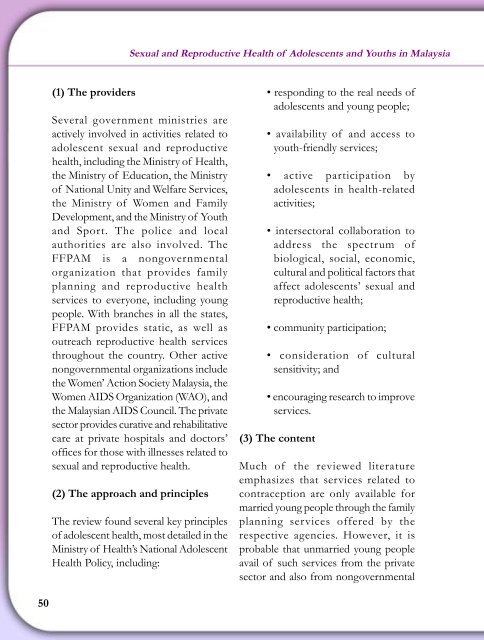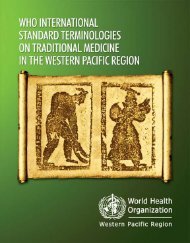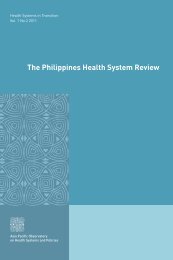Download pdf, 989kb - WHO Western Pacific Region - World Health ...
Download pdf, 989kb - WHO Western Pacific Region - World Health ...
Download pdf, 989kb - WHO Western Pacific Region - World Health ...
Create successful ePaper yourself
Turn your PDF publications into a flip-book with our unique Google optimized e-Paper software.
Sexual and Reproductive <strong>Health</strong> of Adolescents and Youths in Malaysia<br />
(1) The providers<br />
Several government ministries are<br />
actively involved in activities related to<br />
adolescent sexual and reproductive<br />
health, including the Ministry of <strong>Health</strong>,<br />
the Ministry of Education, the Ministry<br />
of National Unity and Welfare Services,<br />
the Ministry of Women and Family<br />
Development, and the Ministry of Youth<br />
and Sport. The police and local<br />
authorities are also involved. The<br />
FFPAM is a nongovernmental<br />
organization that provides family<br />
planning and reproductive health<br />
services to everyone, including young<br />
people. With branches in all the states,<br />
FFPAM provides static, as well as<br />
outreach reproductive health services<br />
throughout the country. Other active<br />
nongovernmental organizations include<br />
the Women’ Action Society Malaysia, the<br />
Women AIDS Organization (WAO), and<br />
the Malaysian AIDS Council. The private<br />
sector provides curative and rehabilitative<br />
care at private hospitals and doctors’<br />
offices for those with illnesses related to<br />
sexual and reproductive health.<br />
(2) The approach and principles<br />
The review found several key principles<br />
of adolescent health, most detailed in the<br />
Ministry of <strong>Health</strong>’s National Adolescent<br />
<strong>Health</strong> Policy, including:<br />
• responding to the real needs of<br />
adolescents and young people;<br />
• availability of and access to<br />
youth-friendly services;<br />
• active participation by<br />
adolescents in health-related<br />
activities;<br />
• intersectoral collaboration to<br />
address the spectrum of<br />
biological, social, economic,<br />
cultural and political factors that<br />
affect adolescents’ sexual and<br />
reproductive health;<br />
• community participation;<br />
• consideration of cultural<br />
sensitivity; and<br />
• encouraging research to improve<br />
services.<br />
(3) The content<br />
Much of the reviewed literature<br />
emphasizes that services related to<br />
contraception are only available for<br />
married young people through the family<br />
planning services offered by the<br />
respective agencies. However, it is<br />
probable that unmarried young people<br />
avail of such services from the private<br />
sector and also from nongovernmental<br />
50

















